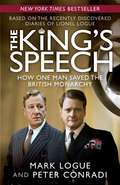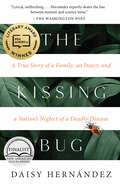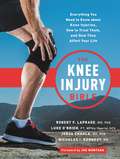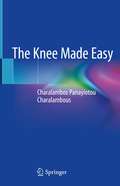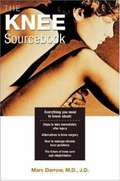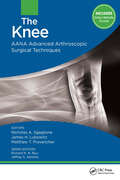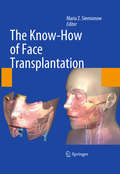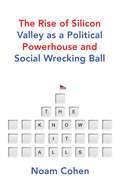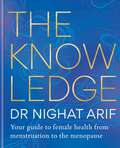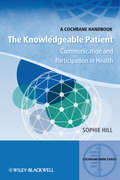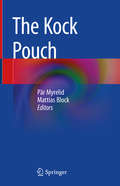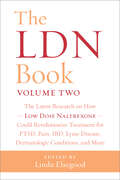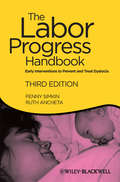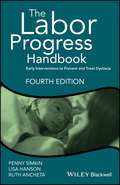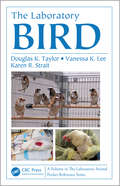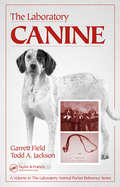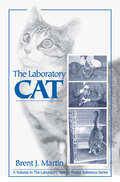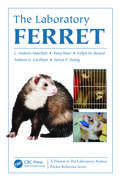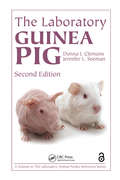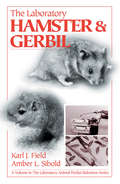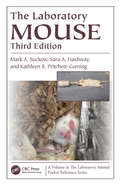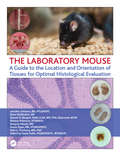- Table View
- List View
The King's Speech: How One Man Saved the British Monarchy
by Mark Logue Peter ConradiIt's the eve of World War II, and King Edward VIII has abdicated the throne of England to marry the woman he loves. Never has the nation needed a leader more. But the new monarch, George VI--father of today's Queen Elizabeth II--is painfully shy and cursed with a terrible stammer. How can he inspire confidence in his countrymen when he cannot even speak to them? Help arrives in speech therapist Logue, who not only is a commoner, but Australian to boot. Will he be able to give King George his voice? The King's Speech tells an inspiring tale of triumph over adversity and the unlikely friendship between a reluctant king and the charismatic subject who saved the throne.
The Kissing Bug: A True Story Of A Parasite And A Nation's Neglect Of A Deadly Disease
by Daisy HernándezWinner of the PEN/Jean Stein Book Award National Book Foundation Science + Literature Selection Finalist for New American Voices Award and Lammy Award for Bisexual Nonfiction A TIME, NPR, Chicago Public Library, Science for the People, WYNC, WBUR Radio Boston, and The Stacks Podcast Best Book of the Year Longlisted for the PEN Open Book Award As heard on Fresh Air Growing up in a New Jersey factory town in the 1980s, Daisy Hernández believed that her aunt had become deathly ill from eating an apple. No one in her family, in either the United States or Colombia, spoke of infectious diseases. Even into her thirties, she only knew that her aunt had died of Chagas, a rare and devastating illness that affects the heart and digestive system. But as Hernández dug deeper, she discovered that Chagas?or the kissing bug disease?is more prevalent in the United States than the Zika virus. After her aunt’s death, Hernández began searching for answers. Crisscrossing the country, she interviewed patients, doctors, epidemiologists, and even veterinarians with the Department of Defense. She learned that in the United States more than three hundred thousand people in the Latinx community have Chagas, and that outside of Latin America, this is the only country with the native insects?the “kissing bugs”?that carry the Chagas parasite. Through unsparing, gripping, and humane portraits, Hernández chronicles a story vast in scope and urgent in its implications, exposing how poverty, racism, and public policies have conspired to keep this disease hidden. A riveting and nuanced investigation into racial politics and for-profit healthcare in the United States, The Kissing Bug reveals the intimate history of a marginalized disease and connects us to the lives at the center of it all.
The Knee Injury Bible: Everything You Need to Know about Knee Injuries, How to Treat Them, and How They Affect Your Life
by Robert F. LaPrade Luke O'Brien Jorge Chahla Nick KennedyFrom prominent experts in orthopedics and sports medicine, a comprehensive guide for anyone with knee injury or chronic knee pain: how injuries occur, how to treat problems, and how to return to the life and sports you love Knee pain and knee injury happen to people at any age and across all walks of life. And they are very common: more than 1 million people underwent arthroscopic knee surgery last year. It can be confusing to navigate the many different treatment options, and surgery and physical therapy are taxing processes on many levels. In The Knee Injury Bible, some of the country's foremost experts on orthopedics and sports medicine combine their expertise to share a definitive resource for patients. In clear, readily understandable language, the authors cover: types of injuries and pain, and how they happenwhich tests are necessary and which are notwhat to ask at doctor visitswhat to expect when undergoing surgerybasic physical therapy exerciseshealthy eating during the recovery periodhow to set expectations and return to the activities and sports you loveChapters also include inspiring stories from other patients and prominent athletes to show readers that they are not alone -- and they can recover and live normally again.
The Knee Made Easy
by Charalambos Panayiotou CharalambousThis book provides a concise and accessible resource for evaluating, diagnosing, and managing common knee disorders. The chapters are presented in a clear, and easily understood style so that practitioners can readily apply the information in their day-to-day clinical practice. The Knee Made Easy opens with discussion of the anatomy, biomechanics, clinical examination and radiological imaging of the knee, followed by commonly encountered clinical symptoms and conditions of the knee. Each clinical condition is demonstrated with the background, presentation, investigations, and treatment options. Medical students, generalist doctors, junior orthopaedic doctors, and physiotherapists will find this book to be an essential go-to guide for effectively treating the most common knee disorders and improving patients' care.
The Knee Sourcebook
by Marc Darrow Laura O'HareThis is a guide explaining the causes, symptoms, and treatments for common injuries and chronic conditions of the knee. It also makes clear what to do immediately after an injury to avoid more harm and discusses the benefits of remedy versus surgery.
The Knee: AANA Advanced Arthroscopic Surgical Techniques (AANA Advanced Arthroscopic Techniques series)
by Nicholas Sgaglione James Lubowitz Matthew ProvencherCo-published with the Arthroscopy Association of North America, The Knee: AANA Advanced Arthroscopic Surgical Techniques is a comprehensive technique-based book that presents the latest diagnostic and reconstructive techniques in arthroscopic surgery for the knee.The Knee: AANA Advanced Arthroscopic Surgical Techniques is authored by premier arthroscopic surgeons Drs. Nicholas A. Sgaglione, James H. Lubowitz, Matthew T. Provencher, and their international list of expert contributors. This comprehensive resource includes preferred physical examination testing and diagnostic imaging choices in pre-operative planning and patient selection, state-of-the-art step-by-step description of the procedures, detailed surgical equipment lists to perform each procedure, clear and precise indications for surgery and the thoughtful rationale behind stated contraindications, controversial indications, post-operative protocols, and potential complications.The written text is supported by numerous color images and a website with invaluable, narrated video clips depicting disease-specific arthroscopic techniques specific to the knee.Features inside The Knee: AANA Advanced Arthroscopic Surgical Techniques Narrated video accompanies all surgical techniques, focusing on the stepwise approach to each operation Consistent organization throughout the book results in a bulleted and user-friendly interface for a quick reference or prolonged study Top 5 Technical Pearls for each procedure to enhance outcomes and to avoid common pitfalls and complications High-quality artwork and figures to complement clinical images Equipment and surgical technique checklists for quick reference prior to surgery Each expert contributor was chosen for his or her expertise for a specific topic related to The Knee, so the reader benefits by the highest quality and treatment recommendations to provide state-of-the-art care to his or her patient. Some chapter topics include:-Arthroscopic Reduction and Fixation of Tibial Plateau and Eminence Fractures-Arthroscopic Treatment of Patellar Tendinopathy-Arthroscopic Meniscal Repair-Novel Techniques in Articular Cartilage Restoration -Advances in Anterior Cruciate Ligament Reconstruction
The Knife Man: Blood, Body Snatching, and the Birth of Modern Surgery
by Wendy MooreThe vivid, often gruesome portrait of the 18th century pioneering surgeon and father of modern medicine, John Hunter. In the gothic horror story, Dr Jekyll and Mr Hyde, the house of the genial doctor turned fiend is reputedly based on the home of the 18th century surgeon and anatomist John Hunter. The choice was understandable, for Hunter combined an altruistic determination to advance scientific knowledge with dark dealings that brought him into daily contact with the sinister Georgian underworld. In 18th century London, Hunter was a man both acclaimed and feared. John Hunter revolutionized surgical practice through his groundbreaking experiments. Driven by an insatiable curiosity, he dissected thousands of human bodies, using the knowledge he gained to improve medical care for countless patients, including some very illustrious people, Joshua Reynolds and Lord Byron among them. He was appointed Surgeon Extraordinary to King George III. InThe Knife Man, Wendy Moore unveils a world characterized by hangings at the Tyburn Tree, by gruesome expeditions to dank churchyards, and by countless human dissections in attic rooms — large sums were paid to body-snatchers for stolen corpses which were delivered to his back door. Meticulously researched,The Knife Manis a fascinating portrait of a scientist determined to haul surgery out of the realm of superstition and into the dawn of modern medicine.
The Know-How of Face Transplantation
by Maria Z. SiemionowThe book is laid out in 6 sections: 1. Preclinical Approaches to Face Transplantation 2. Clinical Aspects in Preparation to Face Transplantation in Humans 3. Approval Process of Face Transplantation in Humans 4. Social and Public Relations in Face Transplantation 5. World Experience with Face Transplantation in Humans 6. Future Directions in Face Transplantation This book spans the entire process of a face transplantation, from detailing the anatomy of the face to considering the social and ethical challenges of the procedure. This rigorous presentation of face transplantation also includes the anesthesia involved, the role of Institutional Review Boards in approving the operation, the financial aspects and media response. Since the authorship is international, the book considers the different perspectives, approaches and responses from across the world.
The Know-How of Face Transplantation
by Maria Z. SiemionowThe book is laid out in 6 sections:1. Preclinical Approaches to Face Transplantation2. Clinical Aspects in Preparation to Face Transplantation in Humans3. Approval Process of Face Transplantation in Humans4. Social and Public Relations in Face Transplantation5. World Experience with Face Transplantation in Humans6. Future Directions in Face TransplantationThis book spans the entire process of a face transplantation, from detailing the anatomy of the face to considering the social and ethical challenges of the procedure. This rigorous presentation of face transplantation also includes the anesthesia involved, the role of Institutional Review Boards in approving the operation, the financial aspects and media response. Since the authorship is international, the book considers the different perspectives, approaches and responses from across the world.
The Know-It-Alls: The Rise of Silicon Valley as a Political Powerhouse and Social Wrecking Ball
by Noam CohenThe world&’s tech giants are at the centre of controversies over fake news, free speech and hate speech on platforms where influence is bought and sold. Yet, at the outset, almost everyone thought the internet would be a positive, democratic force, a space where knowledge could be freely shared to enable everyone to make better-informed decisions. How did it all go so wrong? Noam Cohen reports on the tech libertarians of Silicon Valley, from the self-proclaimed geniuses Jeff Bezos, Peter Thiel, Reid Hoffman and Mark Zuckerberg to the early pioneers at Stanford University, who have not only made the internet what it is today but reshaped society in the process. It is the story of how the greed, bias and prejudice of one neighbourhood is fracturing the Western world.
The Knowledge: Your guide to female health – from menstruation to the menopause
by Dr Nighat ArifTHE ESSENTIAL WOMEN'S HEALTH BIBLECelebrated GP Dr Nighat Arif brings women's health to the forefront in this extensive guidebook designed to help everyone better understand each of the three key stages of a woman's life: the puberty years, the fertility years and the peri/menopausal years. Every step of the way, Dr Nighat will help you get to know the female body by explaining what is normal, what to expect, how to care for yourself and when to seek help. This book tackles many important topics: from the help available for people with conditions like endometriosis and polycystic ovary syndrome to the symptoms of heart disease to look out for in women.The Knowledge is for everyone - and this book encompasses all experiences, including the perspectives of women of colour, people of all abilities and cultures, and the transgender community to ensure that all groups affected by female health concerns are a part of vital conversations. This is a life-saving book for all genders, ages and communities. From the young preteen hoping to understand their first period, to the couple experiencing fertility issues, to the single father raising teenage daughters, to the person unknowingly experiencing early signs of gynaecological cancer: this book is an indispensable asset for us all.
The Knowledge: Your guide to female health – from menstruation to the menopause
by Dr Nighat ArifTHE ESSENTIAL WOMEN'S HEALTH BIBLECelebrated GP Dr Nighat Arif brings women's health to the forefront in this extensive guidebook designed to help everyone better understand each of the three key stages of a woman's life: the puberty years, the fertility years and the peri/menopausal years. Every step of the way, Dr Nighat will help you get to know the female body by explaining what is normal, what to expect, how to care for yourself and when to seek help. This book tackles many important topics: from the help available for people with conditions like endometriosis and polycystic ovary syndrome to the symptoms of heart disease to look out for in women.The Knowledge is for everyone - and this book encompasses all experiences, including the perspectives of women of colour, people of all abilities and cultures, and the transgender community to ensure that all groups affected by female health concerns are a part of vital conversations. This is a life-saving book for all genders, ages and communities. From the young preteen hoping to understand their first period, to the couple experiencing fertility issues, to the single father raising teenage daughters, to the person unknowingly experiencing early signs of gynaecological cancer: this book is an indispensable asset for us all.
The Knowledgeable Patient: Communication and Participation in Health (CBS- Cochrane Book Series #2)
by Sophie HillLearn how to place communication and participation at the heart of evidence-based healthcare The Knowledgeable Patient: Communication and Participation in Health sits at the forefront of the challenging, changing 21st century landscape. The 'knowledgeable patient' as an individual can take many forms: patient, family carer, consumer advocate, or member of the public interested in health issues. In each of these roles, knowledgeable patients interact with health professionals by asking questions about the evidence for treatment, seeking support, exchanging views, and contributing experiences and new ideas on how to improve the health system. Drawing from several research paradigms, The Knowledgeable Patient is an essential guide to a new era of complex healthcare. Integrating consumer stories and evidence from systematic reviews, it examines key communication and participation issues in a range of contexts, including: surgery safe medicine use chronic disease self management the complexity of multimorbidity notification of rare disease risk. The Knowledgeable Patient is international in scope with researched examples spanning living in the community, health service treatment, governance, and policy making. It provides health professionals with new ideas, concepts, evidence, and practical tools to understand the central role of communication and participation to a well-functioning health system. It is an ideal reference for undergraduate and postgraduate students studying the health sciences. Watch a video about The Knowledgeable Patient: Communication and Participation in Health from the author, Sophie Hill: bit.ly/xNYCqG
The Kock Pouch
by Pär Myrelid Mattias BlockThis book is about the recently revived technique of Kock pouch in inflammatory bowel disease. It discusses the Kock pouch as an alternative to patients not suitable for a pelvic pouch or where the pelvic pouch has failed. It provides clinicians with all the necessary information on patient guidance and surgical revisions after a long life with a Kock pouch. The reader will learn about the development of the pouch, pre and post-operative strategies, surveillance, complications and the limitations and weaknesses of the method. New pioneering experimental methods used by the authors are also discussed. The use of ileorectal anastomosis and Kock’s continent ileostomy has regained interest as the long term problems of the pelvic pouch have and this book brings the knowledge and valuable experiences of a few experts at international centres to a large audience. This is an indispensable guide for colorectal surgeons, gastroenterologists and stoma therapists involved in the care of patients with inflammatory bowel disease where colectomy is still needed, either in an emergency setting or due to dysplasia or cancer.
The LDN Book, Volume Two: The Latest Research on How Low Dose Naltrexone Could Revolutionize Treatment for PTSD, Pain, IBD, Lyme Disease, Dermatologic Conditions, and More
by Linda ElsegoodA comprehensive examination of Low Dose Naltrexone—a little-known drug with big potential&“[LDN] raises hopes of reversing memory loss in old age.&”—the GuardianA drug that is simultaneously affordable, devoid of severe side effects, and applicable to a wide range of diseases is not often found in the modern pharmaceutical landscape. But as medical professionals and researchers alike continue to discover, Low Dose Naltrexone (LDN) boasts this remarkable combination.LDN, originally prescribed in higher doses as a treatment for opioid addiction, works by blocking opioid receptors, thereby stimulating the production of endorphins, mitigating the inflammatory process, and stabilizing the immune response. Prescribed off-label and administered in small daily doses, this generic drug has proven useful in treating many different ailments.Expanding on the information presented in The LDN Book, Volume 1, which showcased LDN&’s efficacy in treating conditions such as lupus, thyroiditis, autism spectrum disorder, and chronic fatigue, Volume 2 highlights the latest clinical trials, case studies, and research with explanations from a dozen medical professionals on how they are using LDN to help patients suffering from:Chronic painParkinson&’s diseaseDermatologic conditionsTraumatic brain injuryLyme disease and moreThe LDN Book, Volume 2 is both a resource for practitioners, pharmacists, and patients, and a renewed call for further research on the healing potential of this generic drug.
The Labor Progress Handbook
by Penny Simkin Ruth AnchetaThe third edition of The Labor Progress Handbook builds on the success of first two editions and remains an unparalleled resource on simple, non-invasive interventions to prevent or treat difficult labor. Features new to this edition include two new chapters on third and fourth stage labor management and low-technology interventions, a complete analysis of directed versus spontaneous pushing, and additional information on massage techniques.
The Labor Progress Handbook: Early Interventions to Prevent and Treat Dystocia
by Penny Simkin Lisa Hanson Ruth AnchetaPraise for the previous edition: "This…edition is timely, useful, well organized, and should be in the bags of all doulas, nurses, midwives, physicians, and students involved in childbirth."–Journal of Midwifery and Women's Health The Labor Progress Handbook: Early Interventions to Prevent and Treat Dystocia is an unparalleled resource on simple, non-invasive interventions to prevent or treat difficult or prolonged labor. Thoroughly updated and highly illustrated, the book shows how to tailor one’s care to the suspected etiology of the problem, using the least complex interventions first, followed by more complex interventions if necessary. This new edition now includes a new chapter on reducing dystocia in labors with epidurals, new material on the microbiome, as well as information on new counselling approaches specially designed for midwives to assist those who have had traumatic childbirths. Fully referenced and full of practical instructions throughout, The Labor Progress Handbook continues to be an indispensable guide for novices and experts alike who will benefit from its concise and accessible content.
The Laboratory Bird (Laboratory Animal Pocket Reference)
by Douglas K Taylor Vanessa K Lee Karen R StraitLaboratory animals, including birds, play an important role in biomedical research. The humane care and management of these animals is an ongoing concern. A new addition to the acclaimed Laboratory Animal Pocket Reference series, The Laboratory Bird is the first publication dedicated to the care and use of avian species in the research setting.Cove
The Laboratory Canine (Laboratory Animal Pocket Reference)
by Garrett Field Todd A. JacksonLaboratory animals, including dogs, play an important role in biomedical research and medical advances. Dogs have a long history of use in research and have contributed enormously to the health and welfare of both humans and animals. The humane care and management of these animals is a fundamental component of their use in medical research.T
The Laboratory Cat (Laboratory Animal Pocket Reference)
by Brent J. MartinThis guide was created especially for individuals performing research with cats whose duties include animal facility management, animal husbandry, regulatory compliance, and technical procedures involved with their research. Basic information and common procedures are presented in detail.
The Laboratory Ferret (Laboratory Animal Pocket Reference)
by C. Andrew Matchett Rena Marr Felipe M. Berard Andrew G. Cawthon Sonya P. SwingLaboratory animals, including ferrets, play an important role in biomedical research and advances. The humane care and management of these animals remains an ongoing concern. Published in color to provide greater clarity to the techniques and concepts discussed, The Laboratory Ferret presents basic information and common procedures in detail to pro
The Laboratory Guinea Pig
by Donna J. Clemons Jennifer L. SeemanLaboratory animals play an important role in biomedical research and advances. Expanded, updated, and now published in full color to provide greater clarity to the techniques and concepts discussed, this guide presents basic information and common procedures in detail to provide a quick reference for investigators, technicians, and caretakers in the laboratory setting. It includes additional information on the research uses of the guinea pig along with updated medical care information.
The Laboratory Hamster and Gerbil (Laboratory Animal Pocket Reference)
by Karl J. Field Amber L. SiboldThe Laboratory Hamster and Gerbil details basic information and common procedures for individuals performing research with hamsters and gerbils. It includes duties of animal facility management, animal husbandry, regulatory compliance, and technical procedures and assists in the humane care and use of hamsters and gerbils in the laboratory. It prov
The Laboratory Mouse (Laboratory Animal Pocket Reference)
by Mark A. Suckow Sara Hashway Kathleen R. Pritchett-CorningWith the advent of transgenic and other genetic engineering technologies, the versatility and usefulness of the mouse as a model in biomedical research has soared. Revised to reflect advances since the second edition, The Laboratory Mouse continues to be the most accessible reference on the biology and care of the mouse in research settings. This guide presents basic information and common procedures in detail to provide a quick reference source for investigators, technicians, and caretakers on the humane care and use of the mouse. The new edition adds information on novel technologies such as CRISPR-Cas and on housing systems and management practices; it covers new concepts such as pain assessment by facial expression and the importance of nest-building as an assessment tool of well-being. There are now expanded sections on anesthesia and analgesia, and on behavior and enrichment. An ideal quick reference for investigators, technicians, and animal caretakers charged with the care and/or use of mice in a research setting, this book will be particularly valuable to those new to working with mice who need to start research programs using these animals.
The Laboratory Mouse: A Guide to the Location and Orientation of Tissues for Optimal Histological Evaluation
by Susan Ryan Jennifer Johnson Brian DelGiudice Dinesh Bangari Eleanor Peterson Gregory Ulinski Beth ThurbergKey features: High quality full color photographs and descriptive texts on the location and removal of the organs from the mouse Instructive methods and clear visuals for trimming and orienting the organs for paraffin histology to obtain the best possible sections for analysis Full color photomicrographs of the resulting section for each organ stained with hematoxylin and eosin demonstrating important features and landmarks for the histologist to ensure the optimal area for analysis is achieved All in one, easy to use guide organized by individual organs of the laboratory mouse Spiralbound for easy reference in the lab This "one-stop" guide offers an essential resource for any academic, research or development operation where mouse necropsy and/or histology are performed. Connecting the reader ‘from the mouse to the microscope’, it provides a detailed guide for locating, trimming, orientating and embedding of the most frequently investigated tissues collected in the laboratory mouse. It shows where the organs reside in the mouse, how to trim and embed them as well as the resulting optimal sections. This guide brings together the wealth of scattered information into one high-quality text, the emphasis is on providing knowledge that will help histologists and scientists get better results in any downstream assays where ideal sections are needed.
